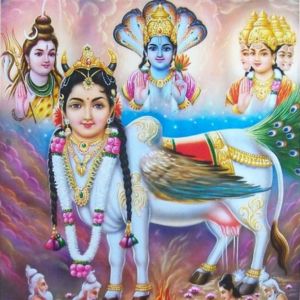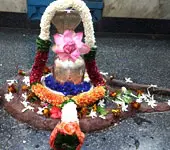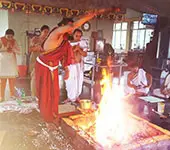Mantra For Love And Affection Between Husband And Wife
Lyrics
(Click here to read more)
दाशरथाय विद्महे सीतानाथाय धीमहि तन्नो रामः प्रचोदयात् daasharathaaya vidmahe seetaanaathaaya dheemahi tanno raamah' prachodayaat....
Lyrics
(Click here)
दाशरथाय विद्महे सीतानाथाय धीमहि तन्नो रामः प्रचोदयात्
daasharathaaya vidmahe seetaanaathaaya dheemahi tanno raamah' prachodayaat
Recommended for you
Mantra to make everyone friendly towards you

klam klaum hreem namah'....
Click here to know more..Kamadhenu Gayatri Mantra For Abundance

शुभकामायै विद्महे कामदात्र्यै च धीमहि । तन्नो धेनुः प्र�....
Click here to know more..Dukhatarana Shiva Stotram

mantraatman niyamin sadaa pashupate bhooman dhruvam shankara shambho paalaya maam bhavaalayapate samsaaraduh'khaarnavaat.....
Click here to know more..
Mantras
Mantras
Click on any topic to open
- 446 Narasimha Mantra: Peace & Reconciliation
- 445 Debt Relief Dattatreya Mantra
- 444 Purity of Mind and Spiritual Growth with Hanuman Mantra
- 443 Wealth Attraction: Prosperity Mantra
- 442 Manifest Blessings: Dattatreya Mantra
- 441 Narasimha Mantra: Shield Against Harm
- 440 Krishna Mantra for Elevating Marital Life and Perfect Bonding
- 439 Strengthen Yourself with Hanuman's Mantra
- 438 Fulfill Your Wishes: Dattatreya Mantra
- 437 Attract Prosperity: Mantra for Abundance
Please wait while the audio list loads..
30
Ganapathy
Shiva
Hanuman
Devi
Vishnu Sahasranama
Mahabharatam
Practical Wisdom
Yoga Vasishta
Vedas
Rituals
Rare Topics
Devi Mahatmyam
Glory of Venkatesha
Shani Mahatmya
Story of Sri Yantra
Rudram Explained
Atharva Sheersha
Sri Suktam
Kathopanishad
Ramayana
Mystique
Mantra Shastra
Bharat Matha
Bhagavatam
Astrology
Temples
Spiritual books
Purana Stories
Festivals
Sages and Saints
